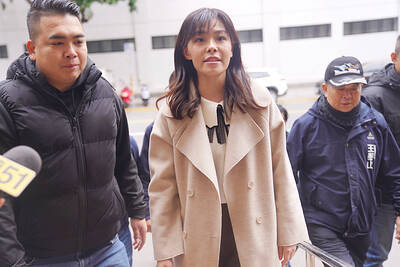Taoyuan International Airport Corp is planning to build a smaller terminal prior to the construction of Taiwan Taoyuan International Airport’s Terminal Three to cope with a rapid increase in the number of passengers arriving in the nation.
The airport’s Terminal One and Terminal Two have a combined capacity of 32 million passengers per year. However, the airport’s passenger volume last year topped 35 million and is estimated to exceed 40 million this year.
Although there are already plans to build Terminal Three, construction is not expected to be completed until 2020. The company has also begun a project to expand the area of Terminal Two, which is scheduled to be completed in 2017.

Photo: Chu Pei-hsiung, Taipei Times
While the Terminal Two expansion project is to increase the facility’s capacity by 5 million passengers per year, the firm said further expansions are needed, as it estimates that the number of passengers serviced by the airport is to grow at a pace of about 10 percent per year.
Minister of Transportation and Communications Chen Chien-yu (陳建宇) yesterday confirmed that a smaller Terminal Four is to be built first, adding that the airport had already briefed the Ministry of Transportation and Communications and the Executive Yuan about its preliminary plan and is ironing out the details of the project.
According to the company, the increase in passenger volume at the airport in recent years was caused by a rise in the number of tourists arriving in the nation via direct cross-strait flights.
Meanwhile, more Taiwanese have been encouraged to go abroad by a growing number of countries offering visa-waiver programs to travelers from Taiwan.
The company said that it would use the space occupied by Terminal One’s parking lot to build Terminal Four, which is projected to be able to service 5 million travelers per year and accommodate four narrow-body aircraft and one wide-body airplane simultaneously.
While the capacity of Terminal Three is projected to reach 45 million passengers per year by 2042, the firm estimated that 86 million travelers will pass through the airport yearly by 2042, necessitating the construction of Terminal Four to help meet demand.
The company plans for Terminal Four to employ an automated system to automatically adjust lighting and air-conditioning based on the number of passengers inside the terminal.
The company has yet to decide whether to relocate some airlines from Terminals One and Two to Terminal Four, or to allow budget airlines to use the new structure.

The US government has signed defense cooperation agreements with Japan and the Philippines to boost the deterrence capabilities of countries in the first island chain, a report by the National Security Bureau (NSB) showed. The main countries on the first island chain include the two nations and Taiwan. The bureau is to present the report at a meeting of the legislature’s Foreign Affairs and National Defense Committee tomorrow. The US military has deployed Typhon missile systems to Japan’s Yamaguchi Prefecture and Zambales province in the Philippines during their joint military exercises. It has also installed NMESIS anti-ship systems in Japan’s Okinawa

‘WIN-WIN’: The Philippines, and central and eastern European countries are important potential drone cooperation partners, Minister of Foreign Affairs Lin Chia-lung said Minister of Foreign Affairs Lin Chia-lung (林佳龍) in an interview published yesterday confirmed that there are joint ventures between Taiwan and Poland in the drone industry. Lin made the remark in an exclusive interview with the Chinese-language Liberty Times (the Taipei Times’ sister paper). The government-backed Taiwan Excellence Drone International Business Opportunities Alliance and the Polish Chamber of Unmanned Systems on Wednesday last week signed a memorandum of understanding in Poland to develop a “non-China” supply chain for drones and work together on key technologies. Asked if Taiwan prioritized Poland among central and eastern European countries in drone collaboration, Lin

NO CONFIDENCE MOTION? The premier said that being toppled by the legislature for defending the Constitution would be a democratic badge of honor for him Premier Cho Jung-tai (卓榮泰) yesterday announced that the Cabinet would not countersign the amendments to the local revenue-sharing law passed by the Legislative Yuan last month. Cho said the decision not to countersign the amendments to the Act Governing the Allocation of Government Revenues and Expenditures (財政收支劃分法) was made in accordance with the Constitution. “The decision aims to safeguard our Constitution,” he said. The Constitution stipulates the president shall, in accordance with law, promulgate laws and issue mandates with the countersignature of the head of the Executive Yuan, or with the countersignatures of both the head of the Executive Yuan and ministers or

BACK TO WORK? Prosecutors said they are considering filing an appeal, while the Hsinchu City Government said it has applied for Ann Kao’s reinstatement as mayor The High Court yesterday found suspended Hsinchu mayor Ann Kao (高虹安) not guilty of embezzling assistant fees, reducing her sentence to six months in prison commutable to a fine from seven years and four months. The verdict acquitted Kao of the corruption charge, but found her guilty of causing a public official to commit document forgery. The High Prosecutors’ Office said it is reviewing the ruling and considering whether to file an appeal. The Taipei District Court in July last year sentenced Kao to seven years and four months in prison, along with a four-year deprivation of civil rights, for contravening the Anti-Corruption